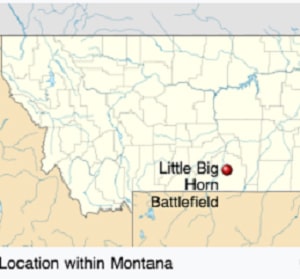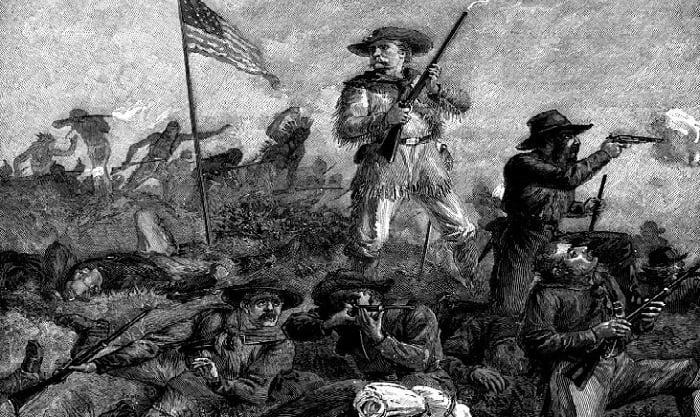Which of the following was a military victory for Native Americans? This question will likely come up in your History quiz on American Indian wars. It is a multiple-choice question, and you might get these to consider:
A, First Seminole War
B, Sand Creek Massacre
C, Wounded Knee Massacre
D, Battle of Little Bighorn
Of these choices, the right one to pick is D – Battle of Little Bighorn. In this article, though, we will delve deeper. There will be detailed information on the location and significance. Thus, if you want a complete understanding, read until the end.
Table of Contents
- What is The Battle of Little Bighorn?
- Why Did The Battle Happen?
- Who Won The Battle of Little Bighorn?
- Who Were The Leaders (On Both Sides)?
- What Are Other Names of the Little Bighorn Battle?
- What Happened During the Battle of Little Bighorn?
- What Happened After the Battle?
- What Is the Site of The Battle Now?
- Is the Battle of the Little Bighorn the Last Major Native American Victory?
- Conclusion
What is The Battle of Little Bighorn?
This is a battle between the U.S Army 7th Cavalry Regiment and the combined forces of the Lakota Sioux, Northern Cheyenne, and Arapaho tribes. It was fought in the Southeastern Montana Territory from June 25 to 26, 1876.
The Natives had about 1,100 to 2,500 warriors, while the 7th Cavalry Regiment had 700 men.
Where Was The Battle of Little Bighorn Fought?
The battle took place along the Little Bighorn River, hence the name.
This river stretched 138 miles in the states of Montana and Wyoming. It flows through a deep canyon and issues onto the plains at the Montana-Wyoming border. From its canyon, the river flows north and across the Crow Indian Reservation. It passes by the Lodge Grass, Wyola, and Crow Agency towns. Then, it joins the Bighorn River by the Hardin town.
Today, the battle site is marked as the Little Bighorn Battlefield National Monument 5,8 kilometers South of Crow Agency on the river’s Eastern side.
Why Did The Battle Happen?
The battle was a part of the Great Sioux War of 1876, which is also commonly referred to as the Black Hills War. The U.S. wanted to take ownership of the Black Hills, as gold had been discovered there. American settlers crept on Native American lands, and the Natives fought back to maintain their ownership.
Who Won The Battle of Little Bighorn?
Even though it is not the biggest Native American victory against the American military, It was, indeed, an overwhelming native victory.
The U.S commander George Armstrong Custer, his two brothers, and his brother-in-law was killed. 268 soldiers died with them and 55 were gravely wounded.
On the other hand, it was estimated that the native death toll only reached 135, and 160 were wounded.
Who Were The Leaders (On Both Sides)?
On the Native Americans’ Side:
For the Lakota Sioux Tribe:
Hunkpapa:
- Black Moon
- Bull Head
- Chasing Eagle
- Chief Gall
- Crow King
- Four Horns
- Iron Hawk
- Moving Robe Women
- One Bull
- Rain-In-The-Face
- Sitting Bull
- Spotted Horn Bull
Sihasapa:
- Crawler
- Kill Eagle
Minneconjou:
- Chief Hump
- Black Moon
- Dog-With-Horn
- Dog Backbone
- Flying By
- Feather Earring
- Looks Up
- Lame Deer
- Red Horse
- White Bull
Sans Arc:
- Cloud Man
- Long Road
- Red Bear
- Spotted Eagle
Oglala:
- American Horse The Elder
- Black Elk
- Black Fox II
- Chief Long Wolf
- Crazy Horse
- Flying Hawk
- He Dog
- Kicking Bear
- Running Eagle
- White Cow Bull
Brule:
- Brave Bird
- Hollow Horn Bear
- Two Eagles
Two Kettles:
- Runs-The-Enemy
For the Dakota Sioux Tribe:
Low Yanktonai:
- Long Tree
- Iron Bear
- Medicine Cloud
- Thunder Bear
Wahpekute:
- Inkpaduta
- Sounds-The-Ground-As-He-Walks
- White Eagle
- White Tracking Earth
For the Northern Cheyenne Tribe:
- Antelope Women
- Bear-Walks-On-A-Ridge
- Black Hawk
- BobTail Horse
- Brave Wolf
- Buffalo Calf Road Woman
- Crooked Nose
- Horse Road
- Lame White Man
- Little Shield
- Old Bear
- Two Moons
- Wooden Leg
- Yellow Horse
On the U.S 7th Calvary Regiment’s Side:
- Commander: Lieutenant Colonel George A. Custer
- Battalion Custer:
- Captain Thomas Custer Company C
- First Lieutenant Algernon Smith Company E
- Captain George Yates Company F
- Captain Myles Keogh Company I
- First Lieutenant James Calhoun Company L
- Battalion Reno:
- Captain Myles Moylan Company A
- First Lieutenant Donald McIntosh Company G
- Captain Thomas French Company M
- Battalion Benteen
- Captain Thomas Weir Company D
- Captain Frederick Benteen Company H
- First Lieutenant Edward Settle Godfrey Company K
- Pack Train
- Commander: First Lieutenant Edward Gustave Mathey
- Captain Thomas McDougall Company B
- Interpreters & Scouts
- Chief of Scouts: Second Lieutenant Charles Varnum
What Are Other Names of the Little Bighorn Battle?
To the Lakota tribe and other Plains Indians, the battle was referred to as the Battle of the Greasy Grass. Today, historians also call it the Custer’s Last Stand.
What Happened During the Battle of Little Bighorn?
- June 24 – The U.S. Indian scouts arrived at the Crow’s Nest, which was an overlook 23 kilometers East of the Little Bighorn River.
- June 25 – The scouts reported to Custer that they noticed a large pony herd and signs of a village about 24 kilometers away. They also saw cooking fires about 16 kilometers away.
- June 26 – Custer receives a report that his troops have left behind a trail and decides to attack the village that the scouts located. He divides his 12 companies into 3 battalions for the engagement.
However, the Native Americans who spotted his trail actually left without notifying the rest of the village. So, the size of the village was very large. The scouts did warn Custer of this, but he believed that they would break up and scatter, and he proceeded to attack.
Ultimately, the U.S. was defeated and Custer was killed.
What Happened After the Battle?
Right after the battle, the village on the Little Bighorn split into small groups and scattered to ensure that there was enough grass and game to sustain the people and horses. They celebrated and feasted. Many of them also returned to their reservation.
Even though the Natives left the battle victorious, this battle was the beginning of the end of the “Indian Wars.” Since then, it has been denoted as “the Indians’ last stand.”
In October 1876, the U.S. gathered around 2,000 men and headed for another battle, with General Nelson A. Miles in command. On May 7, the Great Sioux War of 1876 ended. Miles defeated the last band of the Miniconjou Sioux.
What Is the Site of The Battle Now?
Currently, the battle site is preserved as the Little Bighorn Battlefield National Monument. Before that, though:
- In 1879, it was maintained as a U.S. national cemetery for the 7th Cavalry troopers.
- In 1946, it was renamed the Custer Battlefield National Monument to acknowledge Custer’s role.
- In 1879, it started to be memorialized with a temporary monument.
- In 1881, a marble obelisk was erected to honor the U.S. dead.
- In 1890, marble blocks were added to mark the places soldiers fell.
- In 1991, a bill passed to change its name and authorized an Indian Memorial to be constructed.
- In 1999, red granite markers were added to mark the places Native American warriors fell.
Is the Battle of the Little Bighorn the Last Major Native American Victory?
No. The Battle of the Little Bighorn was not the last major Native American victory over the U.S. Army. Nonetheless, it is worth learning about.
Conclusion
Which of the following was a military victory for Native Americans? As you have read, the short answer is the Battle of the Little Bighorn. This battle took place along the Little Bighorn River from June 25 to 26, 1876. It was between the U.S Army 7th Cavalry Regiment and the combined powers of the Lakota Sioux, Northern Cheyenne, and Arapaho tribes. The Little Bighorn Battle was a part of a more extensive conflict: the Great Sioux War of 1876.
Hopefully, this has been interesting and informative. Leave your thoughts and questions down below in the comments. Please help us share this with other readers, like your classmates, as well. Thank you!

I am Everett Bledsoe, taking on the responsibility of content producer for The Soldiers Project. My purpose in this project is to give honest reviews on the gear utilized and tested over time. Of course, you cannot go wrong when checking out our package of information and guide, too, as they come from reliable sources and years of experience.




